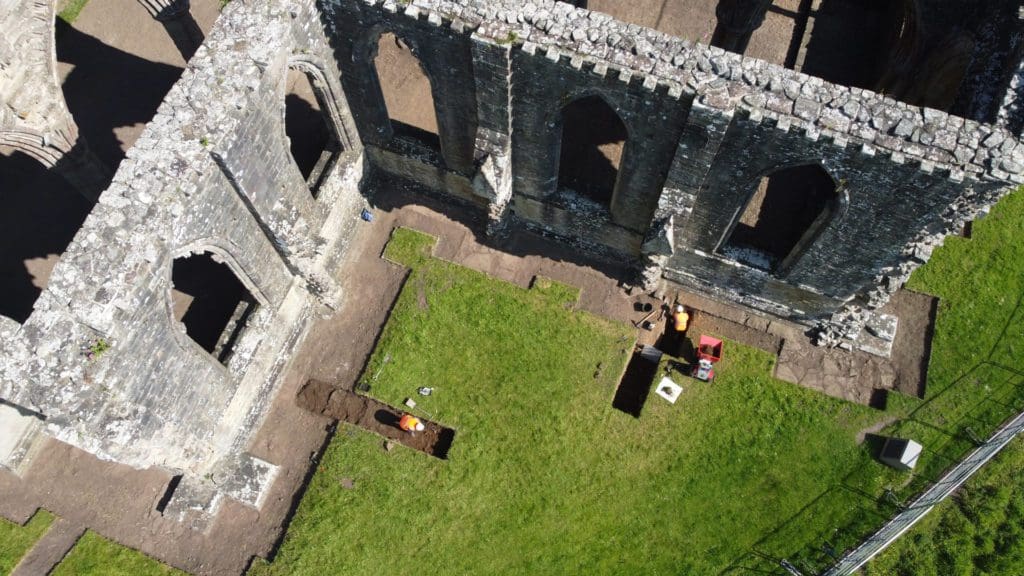Cadw is leading an ambitious five-year programme of essential conservation works at the iconic Tintern Abbey.
Tintern’s greatest glory, the superb Gothic Church, has stood on the banks of the River Wye for over 700 years. Over the centuries, the weather has eroded the soft medieval stonework and a large-scale conservation project is now underway to preserve the monument and make it safe for visitors.
Archaeological investigations have begun on site to help inform the conservation works, which will address natural erosion and weathering to the fragile 750-year-old sandstone masonry of the Abbey Church. This includes detailed recording of the standing remains of the building and excavations to help understand the nature of below ground archaeology.
The conservation works will require a very high and heavy scaffold to reach the weathered and crumbling sandstone of the upper walls of the church. Before the scaffold is installed, Black Mountains Archaeology and ArchaeoDomus have been commissioned to undertake archaeological evaluations – to avoid any ancient fragile features buried in the ground that may be damaged and to ensure that the scaffold has a stable base.
Head of Cadw, Gwilym Hughes, said: “For over 700 years the abbey’s church has been welcoming worshippers, wealthy patrons and visitors to this tranquil location – and once again it requires some attention.
“The scale and nature of the project makes it the most ambitious and innovative conversation project for Cadw to undertake in decades.
“This conservation project will greatly increase our knowledge of Tintern Abbey, its history, buildings and archaeology and will safeguard the site for current and future generations.
“This will be the first year of a very ambitious investigation into the buried history of Tintern Abbey and will expand from this east end of the Church to most of the interior and surrounding ground over the next few years.”
Along with a programme of building analysis, historical research and geophysical survey, the results of the excavations will be made publicly available at the end of the project and will greatly enhance what’s known about Tintern and aid its future management and conservation.
Richard Lewis, Managing Director, Black Mountains Archaeology, said: “We are very excited to be supporting Cadw with this ambitious, landmark conservation programme for Tintern Abbey’s Great Church. This will be the first time that the Abbey Church will have been investigated in such detail since the Ministry/Office of Works carried out their landscaping and excavations nearly 100 years ago and offers an exciting opportunity for us to learn more about the magnificent building.
We are currently investigating a large area of the church and we are recording the monument using the latest modern digital archaeological recording techniques. We are using cutting edge photogrammetry and laser methods, together with bespoke digital software to record the investigations in 3D. This will provide a detailed, holistic and lasting record for the future.
So far we have recovered many interesting artifacts from the late 13th century to the modern period. These include, fragments of rare medieval window glass, floor tiles and pottery, and coins from Henry III (1216-72), George III (1760-1820), through to the Victorian and Edwardian Periods.”
Ross Cook, Buildings Archaeologist and Dendrochronologist at ArchaeoDomus, said “The nature and scope of the investigations at Tintern are unprecedented and will provide the most comprehensive record of a Scheduled Monument in Wales.
The programme of buildings recording will explore every inch of the monument and create a ‘living’ database of information relating to its pre- and post-conservation condition and historical development. This will continue to be added to in the future to support the management of this beautiful and important site. It’s a very exciting project to be a part of and great to work alongside Cadw and a wonderful team including acknowledged specialists in the history of the Cistercians and masonry conservators.
The excavations have already helped improve our understanding of the construction and development of the Abbey Church in both the pre- and post-Reformation medieval world. Both myself and Black Mountains Archaeology look forward to sharing our findings in the coming months and years.”
The excavations, which will take place in phases across the five-year project, are fenced off to protect the public and the archaeology. The Black Mountains team will give twice-daily talks (Monday to Friday 11am and 2pm) until the end of June from a safe viewing point in the south aisle of the church.
This first phase of excavations will end in early July and it is hoped that conservation works to the east end of the church will begin later in 2023.
Tintern Abbey remains open, however there will be restricted access to some areas of the interior of the abbey church throughout the project.

